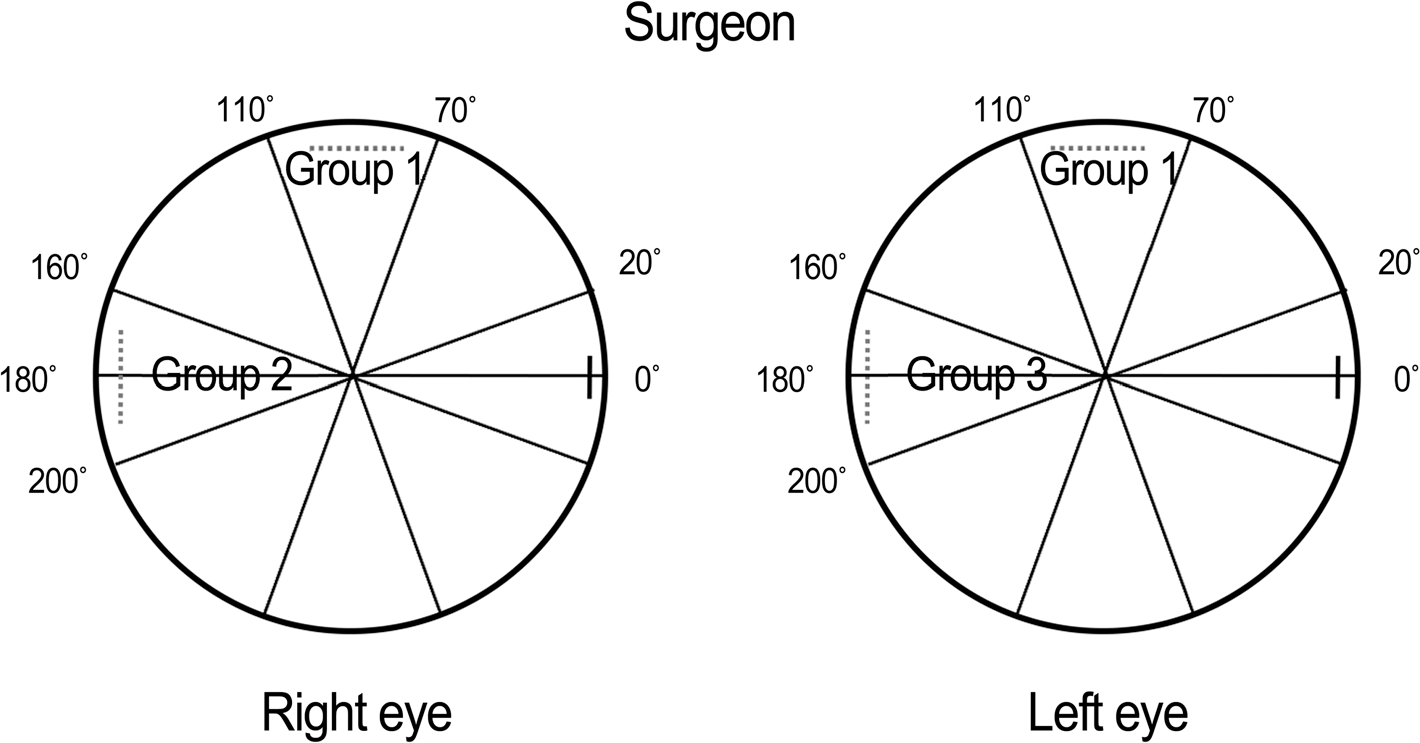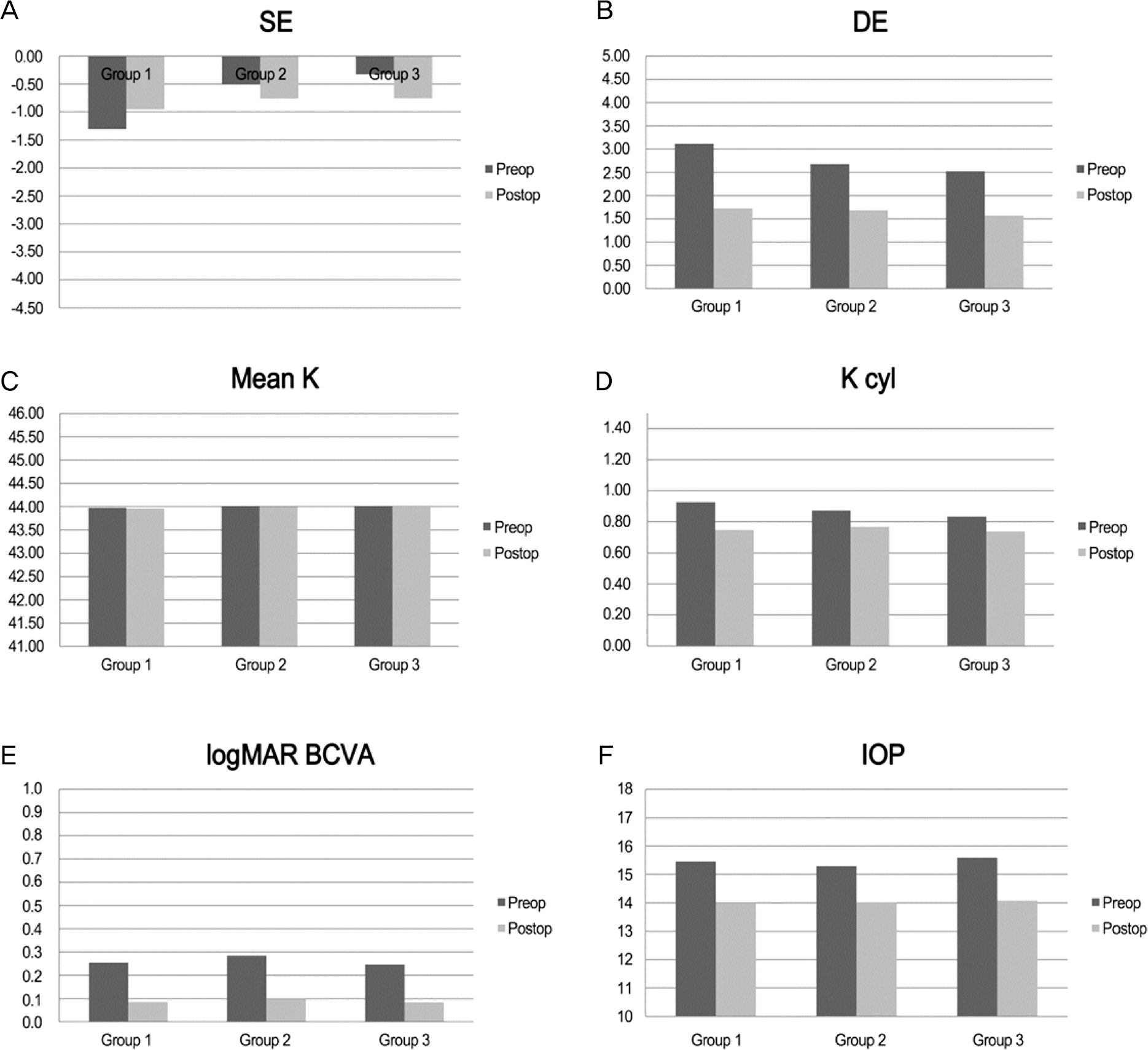Abstract
Purpose
To compare the safety and efficacy of cataract surgery using nasal clear corneal incision (CCI) versus superior or tem-poral CCIs in Korean patients.
Methods
A retrospective comparative study was conducted. Patients underwent cataract surgery using CCI performed by 3 sur-geons between January 2012 and December 2013.The patients were divided into the following 3 groups based on CCI direction: nasal CCIs (group I), superior CCIs (Group II), and temporal CCIs (Group III). To assess usability, surgically induced astigma-tism (SIA), best-corrected visual acuity (BCVA), intraocular pressure (IOP), keratometry reading, and refractive errors at base-line and 1 month after surgery were compared. Operation times were compared between groups. To assess safety, intraoperative complications and wound stability were compared.
Results
A total of 1,374 eyes (Group I, 283 eyes; Group II, 587 eyes; Group III, 504 eyes) were included in the present study. The SIA was not significantly different among the 3 groups. The postoperative mean BCVA, IOP, keratometry reading and spher-ical equivalent as well as the mean operation times were not significantly different between the 3 groups (14.04 ± 3.79 vs. 13.80 ± 3.27 vs. 13.80 ± 3.70; p = 0.473). The rate of intraocular complications and incidence of corneal wound suture were not sig-nificantly different between the 3 groups (1.7% vs. 3.2% vs. 2.3%; p = 0.378).
Go to : 
References
1. Dewey S, Beiko G, Braga-Mele R. . Microincisions in cataract surgery. J Cataract Refract Surg. 2014; 40:1549–57.

2. Alió J, Rodríguez-Prats JL, Galal A, Ramzy M.Outcomes of mi-croincision cataract surgery versus coaxial phacoemulsification. Ophthalmology. 2005; 112:1997–2003.

3. Alió JL, Agdeppa MC, Rodríguez-Prats JL. . Factors influenc-ing corneal biomechanical changes after microincision cataract surgery and standard coaxial phacoemulsification. J Cataract Refract Surg. 2010; 36:890–7.

4. Barequet IS, Yu E, Vitale S. . Astigmatism outcomes of hori-zontal temporal versus nasal clear corneal incision cataract surgery. J Cataract Refract Surg. 2004; 30:418–23.

5. Leaming DV. Practice styles and preferences of ASCRS mem-bers--1997 survey. J Cataract Refract Surg. 1998; 24:552–61.

6. Amesbury EC, Miller KM. Correction of astigmatism at the time of cataract surgery. Curr Opin Ophthalmol. 2009; 20:19–24.

7. Jiang Y, Le Q, Yang J, Lu Y. Changes in corneal astigmatism and high order aberrations after clear corneal tunnel phacoemulsifica-tion guided by corneal topography. J Refract Surg. 2006; 22((9 Suppl)):S1083–8.

8. Gonçalves FP, Rodrigues AC.Phacoemulsification using clear cor-nea incision in steepest meridian. Arq Bras Oftalmol. 2007; 70:225–8.
9. Altan-Yaycioglu R, Akova YA, Akca S. . Effect on astigma-tism of the location of clear corneal incision in phacoemulsifica-tion of cataract. J Refract Surg. 2007; 23:515–8.

10. Pakravan M, Nikkhah H, Yazdani S. . Astigmatic outcomes of temporal versus nasal clear corneal phacoemulsification. J Ophthalmic Vis Res. 2009; 4:79–83.
11. Kohnen S, Neuber R, Kohnen T. Effect of temporal and nasal un-sutured limbal tunnel incisions on induced astigmatism after phacoemulsification. J Cataract Refract Surg. 2002; 28:821–5.

12. Yoon JH, Kim KH, Lee JY, Nam DH. Surgically induced astigma-tism after 3.0 mm temporal and nasal clear corneal incisions in bi-lateral cataract surgery. Indian J Ophthalmol. 2013; 61:645–8.

13. Holladay JT, Cravy TV, Koch DD. Calculating the surgically in-duced refractive change following ocular surgery. J Cataract Refract Surg. 1992; 18:429–43.

14. Tejedor J, Pérez-Rodríguez JA.Astigmatic change induced by 2.8-mm corneal incisions for cataract surgery. Invest Ophthalmol Vis Sci. 2009; 50:989–94.

Go to : 
 | Figure 1.Patient groups according to incision locations. The incision locations were selected to correspond to the steep axis of the corneal astigmatism. Gray dotted lines indicate the main clear corneal incision. Black lines indicate the side port incision. |
 | Figure 2.Mean changes in ocular parameters. No changes in these parameters, except for mean spherical equivalent (SE), were sig-nificantly different ( p > 0.05). (A) Changes in the mean SE. The amounts of changes between groups were significantly different ( p = 0.000). (B) Changes in mean defocus equivalent. (C) Changes in mean keratometric (K) power. (D) Changes in mean kerato-metric cylindrical (K cyl) power. (E) Changes in best corrected visual acuity (BCVA). (F) Changes in intraocular pressure (IOP). DE = defocus equivalent; Preop = pre-operation; Postop = post-operation. |
Table 1.
Preoperative patient demographics and ocular parameters
Table 2.
Postoperative safety and usability outcomes: intraoperative complications, SIA, incidence of corneal wound sutures
| Group I (n = 283) | Group II (n = 587) | Group III (n = 504) | Total (n = 1,374) | p-value | |
|---|---|---|---|---|---|
| Complication | 6 (2.1) | 4 (0.7) | 8 (1.6) | 18 (1.3) | 0.171* |
| Suture | 9 (3.2) | 10 (1.7) | 12 (2.4) | 31 (2.3) | 0.378* |
| Op. time (min) | 13.80 ± 3.27 | 14.04 ± 3.79 | 13.80 ± 3.70 | 13.90 ± 3.66 | 0.473† |
| (9 to 25) | (9 to 31) | (9 to 29) | (9 to 31) | ||
| BCVA (logMAR) | 0.09 ± 0.21 | 0.10 ± 0.22 | 0.09 ± 0.17 | 0.09 ± 0.20 | 0.407† |
| (0.00 to 1.92) | (0.00 to 2.75) | (0.00 to 1.92) | (0.00 to 2.75) | ||
| IOP (mmHg) | 14.00 ± 3.07 | 14.02 ± 3.33 | 14.08 ± 3.22 | 14.03 ± 3.23 | 0.927† |
| (8 to 25) | (8 to 26) | (8 to 25) | (8 to 27) |
Table 3.
Postoperative efficacy outcomes: ocular parameters
| Group I (n = 283) | Group II (n = 587) | Group III (n = 504) | Total (n = 1,374) | p-value* | |
|---|---|---|---|---|---|
| SE (diopters) | –0.95 ± 1.21 | –0.76 ± 1.04 | –0.75 ± 1.02 | –0.80 ± 1.07 | 0.025 |
| (–5.75 to 1.00) | (–5.25 to 1.63) | (–4.90 to 1.13) | (–5.75 to 1.63) | ||
| DE (diopters) | 1.73 ± 1.32 | 1.69 ± 1.15 | 1.57 ± 1.11 | 1.65± 1.17 | 0.115 |
| (0.00 to 6.00) | (0.00 to 6.75) | (0.00 to 6.55) | (0.00 to 6.75) | ||
| Mean K (diopters) | 43.96 ± 1.67 | 43.99 ± 1.69 | 44.02 ± 1.49 | 44.00 ± 1.61 | 0.851 |
| (35.13 to 48.75) | (34.25 to 48.63) | (37.75 to 48.13) | (34.25 to 48.79) | ||
| SIA (diopters) | 0.55 ± 0.41 | 0.51 ± 0.42 | 0.49 ± 0.40 | 0.51 ± 0.41 | 0.153 |
| (0.00 to 1.98) | (0.00 to 1.98) | (0.00 to 1.90) | (0.00 to 1.98) |




 PDF
PDF ePub
ePub Citation
Citation Print
Print


 XML Download
XML Download